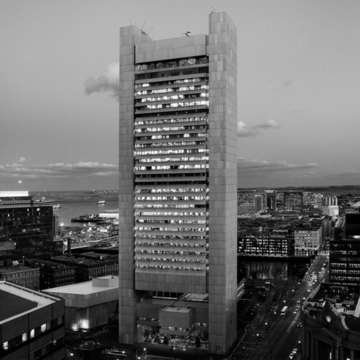Almost a rarity among skyscrapers of the last decades of the twentieth century, the Federal Reserve Bank has become a unique landmark. Prominent night and day by virtue of its reflective aluminum surface, it changes according to light and atmospheric states from pure white to shades of gold and rose. Functional aspects match aesthetic elements as the surface reduces solar heat, the angled spandrels acting as windbreakers. Fortress-like as befits its function, the tower, composed of two grand pylons framing a facade of louvers, occupies only 16 percent of its site. Horizontal elements contain service spaces, a glass-enclosed open lobby, and a gallery as a prelude to the second-floor banking room and the high-security upper stories. Amenities for employees include fine views of the Fort Point Channel from the restaurant and outdoor terraces. The wide-open plaza, with access to public transit, may in the future incorporate a type of landscape that will contribute to a livelier civic space—almost demanded by the density of the district and its location opposite the South Station Transportation Center (FD26).
You are here
Federal Reserve Bank
If SAH Archipedia has been useful to you, please consider supporting it.
SAH Archipedia tells the story of the United States through its buildings, landscapes, and cities. This freely available resource empowers the public with authoritative knowledge that deepens their understanding and appreciation of the built environment. But the Society of Architectural Historians, which created SAH Archipedia with University of Virginia Press, needs your support to maintain the high-caliber research, writing, photography, cartography, editing, design, and programming that make SAH Archipedia a trusted online resource available to all who value the history of place, heritage tourism, and learning.















